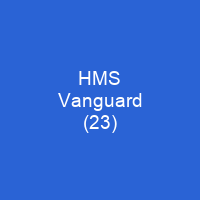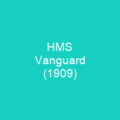HMS Vanguard was a British fast battleship built during the Second World War and commissioned afterwards. She was the biggest and fastest of the Royal Navy’s battleships, the only ship of her class, and the last battleship to be built. Vanguard’s first task after completing her sea trial was to convey King George VI and his family on the first Royal Tour of South Africa.
About HMS Vanguard (23) in brief

The thickness of the main belt was reduced by 1.5 inches to save weight but the primary method chosen to reduce the draught was to increase the beam by 2.5 feet. This exceeded the width of the docks at Rosyth and limited the number of docks that could handle the ship. More pressing commitments forced the preliminary design work to be suspended again in June and when it resumed in October, the design was revised again in light of recent war experience. These changes were approved by the Board of Admiralty on 17 April 1941. The British had enough 15-inch guns and turrets in storage to allow one ship of a modified Lion- class design with four twin-15-inch turrets to be completed faster than the lion-class vessels. The turrets were originally built for the battlecruisers Courageous and Glorious during the First World War, and were removed during the conversions of these ships to aircraft carriers in the 1920s. The main constraint on the construction of any new battleships was the limited available capacity and the time required to build large-calibre guns and their gun turrets. By early 1939 it was clear that the first two Lion- Class battleships could not be delivered before 1943 at the earliest and that further battleship construction would be necessary to match the German and Japanese battleships already under construction.
You want to know more about HMS Vanguard (23)?
This page is based on the article HMS Vanguard (23) published in Wikipedia (as of Dec. 08, 2020) and was automatically summarized using artificial intelligence.







